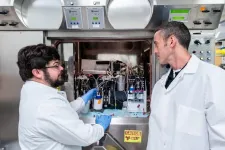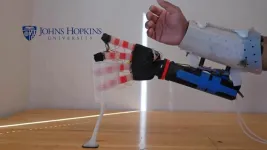Repurposed ALS drug becomes imaging probe to help diagnose neurodegeneration
Scientists at St. Jude Children’s Research Hospital used positron emission tomography (PET) with edaravone, a drug used to treat ALS, to detect oxidative stress
2025-03-05
(Press-News.org)
Positron emission tomography (PET) is a nuclear imaging technique used to diagnose conditions such as cancer. An innovative advance from scientists at St. Jude Children’s Research Hospital is enhancing the technique’s ability to check for signs of neurological disease. The researchers repurposed the drug edaravone, an antioxidant used to treat amyotrophic lateral sclerosis (ALS), as a probe to be used with central nervous system PET imaging. With this technique, the researchers can detect oxidative stress, which leads to brain damage, offering a clear path to detecting neurological conditions. The findings were published today in Nature Biomedical Engineering.
Neurodegenerative diseases, such as ALS and Alzheimer’s disease, are largely diagnosed by physical symptoms that occur when treatment is often too late to be effective. Reactive oxygen and nitrogen species (RONS) are a group of chemically reactive molecules that play important roles in cell signaling and growth. However, accumulation of RONS can cause oxidative stress, leading to tissue injury and dysfunction. Oxidative stress is associated with diseases and conditions affecting the brain and other parts of the central nervous system, resulting in neurodegeneration. Detecting oxidative stress through a noninvasive imaging technique has the potential to shift the diagnosis, and thus treatment, of conditions like ALS and Alzheimer’s disease much earlier when such care can be more beneficial.
Radical burst helps track onset of brain damage
In addition to neurodegenerative disease, oxidative stress is a factor in many other neurological diseases, such as stroke. In such cases, the harm does not just come from the initial injury.
“It’s the subsequent secondary injury, which usually comes from the immune response, which causes the most neurological damage,” explained corresponding author Kiel Neumann, PhD, St. Jude Department of Radiology. “Part of that immune response is a burst of reactive oxygen and nitrogen species, sometimes called an oxidative burst.”
The reactive chemicals released under oxidative bursts include hydroxyl and peroxyl radicals, short-lived chemicals that, in large amounts, can act as a detonator for a cascade of oxidative damage. As an antioxidant, edaravone naturally interacts with RONS, leading Neumann to hypothesize that the drug could be repurposed to enhance imaging efforts. Neumann’s team radiolabeled edaravone, replacing atoms in the molecule with radioactive isotopes to allow him to track the movement and breakdown of the drug. When administered, the radiolabeled drug releases subatomic particles called positrons in amounts unnoticeable by all but a PET scan, wherein it lights up the area where the drug accumulates: alongside the build-up of RONS.
“The goal in imaging is to promote contrast, so we want something that engages with its target rapidly but then also rapidly clears so you can see your target right away,” explained Neumann. “What was unique about this drug is that when it reacts with oxidative stress, it undergoes a massive structural and polarity change which keeps it in the cell and promotes contrast.”
The drug’s excellent ability to bind RONS in tiny doses means it is perfectly suited for PET imaging while it can still be used as an antioxidant treatment at standard doses — a diagnosis and treatment one-two punch. “Our diagnostic tests are on the order of nanograms to micrograms of material, so the body doesn’t even know it’s there,” Neumann said.
“Ultimately, our goal is to use this to impact clinical care. Therapeutic intervention using this technology for clinical disease management is the future.”
Authors and funding
The study’s first authors are Justin Wilde, University of Virginia, and Yu-Yo Sun, National Sun Yat-sen University. The study’s other authors are Zhongxiao Fu, Emily Bian, Melissa Kinkaid, Aden Weybright, William Terrell, Zoraiz Qureshi, James Stone, Bijoy Kundu and Chia-Yi Kuan, University of Virginia; Spenser Simpson, Ethan Hill, Paulina Villanueva, Shashika Perera and Heather Sheppard, St. Jude.
The study was supported by grants from the National Institutes of Health (R01EB028338-01, R01NS125788, R01NS125677, R01NS135793, R21NS127392, R21HD109025, NS135693) and ALSAC, the fundraising and awareness organization of St. Jude.
St. Jude Children's Research Hospital
St. Jude Children's Research Hospital is leading the way the world understands, treats and cures childhood cancer, sickle cell disease, and other life-threatening disorders. It is the only National Cancer Institute-designated Comprehensive Cancer Center devoted solely to children. Treatments developed at St. Jude have helped push the overall childhood cancer survival rate from 20% to 80% since the hospital opened more than 60 years ago. St. Jude shares the breakthroughs it makes to help doctors and researchers at local hospitals and cancer centers around the world improve the quality of treatment and care for even more children. To learn more, visit stjude.org, read St. Jude Progress, a digital magazine, and follow St. Jude on social media at @stjuderesearch.
END
[Attachments] See images for this press release:


ELSE PRESS RELEASES FROM THIS DATE:
2025-03-05
At the height of the COVID-19 pandemic, hospitals frequently ran short of beds in intensive care units. But even earlier, ICUs faced challenges in keeping beds available. With an aging American population, 11% of hospital stays included ICU stays.
Artificial intelligence offers a possible solution, says Indranil Bardhan, professor of information, risk, and operations management and Charles and Elizabeth Prothro Regents Chair in Health Care Management at Texas McCombs. AI models can predict the lengths of time patients will spend in the ICU, helping hospitals better manage their beds and, ideally, cut costs.
But although AI is good at predicting length of stay, ...
2025-03-05
For an abdominal wall hernia repair, also known as a ventral hernia repair, the most common surgical approaches have been laparoscopic and open techniques.
But a new approach for repairing hernias has been steadily growing in popularity: the surgical robot.
Supporters of using the robot method state multiple advantages over traditional laparoscopic and open approaches, including improved surgeon ergonomics.
But there may be downsides to the technology that are going undiscussed.
In a research article published in JAMA Surgery, Brian Fry, M.D., M.S., a ...
2025-03-05
A landmark study reveals that bacterial vaginosis (BV), a condition affecting nearly a third of women worldwide and causing infertility, premature births and newborn deaths, is in fact a sexually transmitted infection (STI), paving the way for a revolution in how it is treated.
Monash University and Alfred Health researchers at the Melbourne Sexual Health Centre say their findings, published today in the New England Journal of Medicine, hold the key to driving down stubborn and distressing recurrence ...
2025-03-05
Johns Hopkins University engineers have developed a pioneering prosthetic hand that can grip plush toys, water bottles, and other everyday objects like a human, carefully conforming and adjusting its grasp to avoid damaging or mishandling whatever it holds.
The system’s hybrid design is a first for robotic hands, which have typically been too rigid or too soft to replicate a human’s touch when handling objects of varying textures and materials. The innovation offers a promising solution for people with hand loss and could improve how robotic arms interact with their environment.
Details about the device appear today in Science Advances.
“The ...
2025-03-05
The Damon Runyon Cancer Research Foundation has named 13 new Damon Runyon Fellows, exceptional postdoctoral scientists conducting basic and translational cancer research in the laboratories of leading senior investigators. The prestigious, four-year Fellowship encourages the nation's most promising young scientists to pursue careers in cancer research by providing them with independent funding ($300,000 total) to investigate cancer causes, mechanisms, therapies, and prevention.
The Foundation has also named ...
2025-03-05
EMBARGOED FOR RELEASE UNTIL 4 P.M. ET, WEDNESDAY, MARCH 5, 2025
Media Contacts:
Renee Tessman, rtessman@aan.com, (612) 928-6137
Natalie Conrad, nconrad@aan.com, (612) 928-6164
Over-the-counter pain relievers linked to improved recovery from concussion
MINNEAPOLIS – People who take over-the-counter pain relievers after a concussion may recover faster than those who do not take pain relievers, according to a preliminary study released today, March 5, 2025, that will be presented at the American Academy of Neurology’s 77th Annual Meeting taking place April 5–9, 2025, in San Diego ...
2025-03-05
MINNEAPOLIS — Some people living with chronic stress have a higher risk of stroke, according to a study published on March 5, 2025, online in Neurology®, the medical journal of the American Academy of Neurology. The study looked at younger adults and found an association between stress and stroke, with no known cause, in female participants, but not male participants. This study does not prove that stress causes stroke; it only shows an association.
“Younger people often experience stress due to the demands and pressures associated with work, including long hours and job insecurity, as well as financial burdens,” ...
2025-03-05
ITHACA, N.Y. – A Cornell University-led collaboration devised a new method for designing metals and alloys that can withstand extreme impacts, which could lead to the development of automobiles, aircraft and armor that can better endure high-speed impacts, extreme heat and stress.
The research, published in Communications Materials, introduces nanometer-scale speed bumps that suppress a fundamental transition that controls how metallic materials deform.
The project was led by Mostafa Hassani, assistant professor of mechanical ...
2025-03-05
AI-generated voices which sound like you are perceived as more trustworthy and likeable, with implications for deep-fakes and manipulation
Article URL: https://plos.io/4baFCW5
Article title: AI-determined similarity increases likability and trustworthiness of human voices
Author countries: Germany
Funding: The author(s) received no specific funding for this work. END ...
2025-03-05
The cacao tree species (Theobroma cacao L.), from which we get chocolate, is likely about 7.5 million years old, with chloroplast genomes indicating that the current known diversity diversified during the Pliocene or Miocene epochs
Article URL: https://plos.io/4gQHlB2
Article title: Comparative analyses of chloroplast genomes of Theobroma cacao from northern Peru
Author countries: Perú
Funding: This study was supported by the Programa Nacional de Investigación Científica y Estudios Avanzados (PROCIENCIA) funded by the Project through the Contract N° 026-2016-FONDECYT “Círculo de Investigación ...
LAST 30 PRESS RELEASES:
[Press-News.org] Repurposed ALS drug becomes imaging probe to help diagnose neurodegeneration
Scientists at St. Jude Children’s Research Hospital used positron emission tomography (PET) with edaravone, a drug used to treat ALS, to detect oxidative stress




